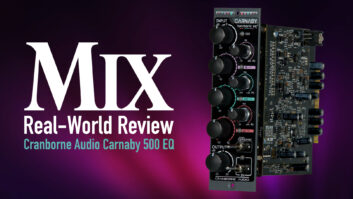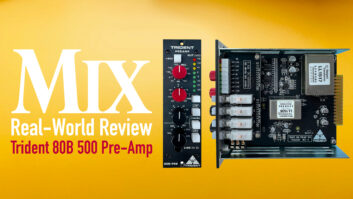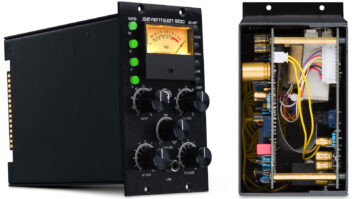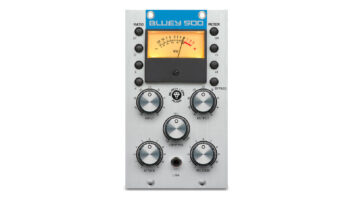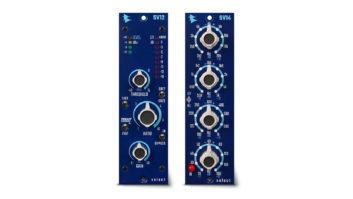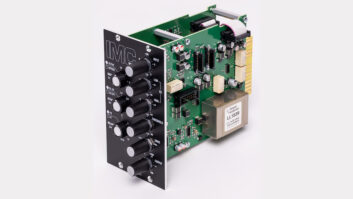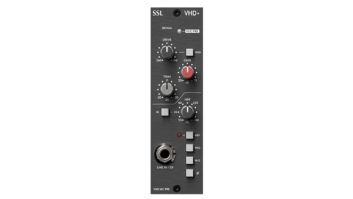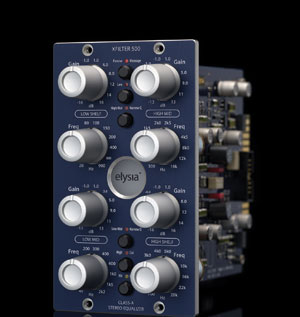
Elysia’s latest 500 Series module is an equalizer that draws from the concepts of both passive and active equalization. The majority of the circuitry is a modern, active, 4-band equalizer. To that, however, they’ve added some bells and whistles that users of elysia’s museq equalizer will find familiar. Then they added the “passive massage” circuit, which provides a little passive EQ flavor for the top end. Altogether, this makes a solid equalizer to apply finishing touches to a mix bus or master, while also offering the versatility to enhance the personality of any individual instrument.
The xfilter 500 is a double-wide module that, like elysia’s xpressor 500, fits into a normal API 500 Series or compatible frame. On the front panel are eight knobs providing frequency select and boost/cut for each of the four bands. I was pleasantly surprised to find that each potentiometer was stepped for the sake of easy recall. Given the fact that stepped pots are usually pricey and rather large, I haven’t seen a lot of them on 500 Series modules. Unlike some stepped rotaries, though, which have a stiff feel when switching between positions, these turn very smoothly and have so many steps that they feel almost like a continuously variable control, until it comes time to document the settings.
Mirror Image
Even though the xfilter 500 affects two channels of audio, there is only one set of controls. elysia believes that attempting to match control settings between a left and a right channel of an equalizer, which is filtering truly stereo information, will always be tedious and inaccurate. Though combining the controls for the two channels rules out the possibility of splitting it up and using it on two different mono sources or for mid-side processing, the tradeoff definitely pays off when using this unit on stereo sources. Setting controls once and not having to perform two-handed adjustments feels more like dialing in a plug-in. There is definitely a modern comfort to it. The entire inner workings are designed to be perfectly stereo matched.
Two of the four bands are sweepable midrange peak filters, while the other two provide high and low shelving. The midrange filters are not fully parametric; however, they each offer two preset Qs: a wide and a narrow. The wide has a smooth, broad character, but narrow isn’t so much narrow as it is simply less wide, with more spread than a surgical, truly narrow equalizer. In most cases, this produces very musical results. It’s really hard to produce unnatural sounds because of the smooth filter curves. The character is different from anything I can think of. It doesn’t have the in-your-face coloration of a Neve or API EQ, and while I would say it sounds more like an SSL EQ, there’s a bit more color than that. The roundness of the curves gives it a feel almost like a passive EQ.
Shelving frequencies range from 20 to 900 Hz and 700 to 28 kHz. The midrange EQs range from 45 Hz to 2.2 kHz and 300 Hz to 16 kHz, so there is enough overlap to cover all bases. While the shelves offer 16 dB of gain boost or cut, the midrange equalizers offer 13 dB of boost and cut. Numbers aside, unlike some equalizers that provide barely audible changes even with a boost of 4 or 5 dB, the xfilter is sensitive enough that appreciable changes can be heard even with very subtle boosts or cuts.
Bells and Whistles
A great-sounding equalizer with a personality all its own and true stereo operation would be enough for many, but it’s the little extras that really make this unit a head turner. For one, each of the shelving filters can be switched from their default functionality to instead become highpass and lowpass filters. The slopes are about 12 dB/octave, which is enough that they can be used as mere problem-solvers, cutting out subsonic information, tape hiss or other extraneous information while still preserving a natural sound.
What really makes the xfiter shine is the resonance bump centered at the roll-off frequency point, which can be introduced when the lowpass or highpass mode is engaged. Effectively, it’s like having a peak filter boosting exactly where the lowpass filter begins working, except that it feels and sounds a bit different than that. In this mode, the low-band gain control stops performing boosts and cuts, and instead only boosts the amount of resonance. As the resonance increases, the filter tightens up with a steeper slope. The effect feels like you are taking energy that is detracting from the clarity of the signal and repurposing to enhance the desirable frequencies of an instrument. Ditching ring-y lows from a kick drum while boosting the actual pulsing tone of the shell is accomplished with such a round pleasant tone. It’s very impressive.
Passive Massage
Stop there and the xfilter 500 is a pretty attractive equalizer, but then there’s one more gem that the xfilter 500 provides: the Passive Massage circuit. Though many consider passive equalizers to be clean and transparent due to their power supplies and amplifiers, elysia plays on one of the more colorful characteristics that capacitors and inductors produce. With a single button to engage it, and no settings to alter its preset functionality, this band provides an additional lowpass filter centered around 12 kHz. When engaged, it doesn’t replace the active high-cut/shelf—it’s an additional, fifth band. The purpose of it, though, is to exploit the way a passive inductor resonates, which is a decidedly different sound than the resonance of the active lowpass filter.
Though it is technically a lowpass filter, it really boosts around 12 kHz, and doesn’t even start rolling off until around 17 kHz and is only down 4 dB by 20 kHz. The sound it produces doesn’t necessarily sound like it’s boosting top or rolling it off; it just alters the characteristic. It keeps punchy top-end transients while eliminating fatiguing sheen around them. Ultimately, it pronounces things, without making them harsher. To that end, it almost acts like the high-frequency component of a multiband compressor, but does so with such a pleasant analog flavor that, in extreme circumstances, produces a focused, musical, harmonic distortion.
In Use
I first tried the xfilter 500 on a track in which the drums were loops of recorded acoustic drum kit. Because they were loops and not actual multitracks, I was essentially mixing a drum stem. My hands were tied when I tried balancing kick versus snare versus toms and cymbals. Likewise, I was unable to process the elements individually. The xfilter 500 came to the rescue. The drums were failing to cut through the distorted bass, acoustic and distorted electric guitar in the track. During the chorus, there was also a thick bed of synths competing for space. Again, using the low cut with a resonance peak at 60 Hz, I was able to get a powerful kick sound. A narrow boost around 4.5 kHz got the snare popping. To excite the cymbals, I tried a shelving boost of the highs but found the high cut with a boosted resonance around 10 kHz helped pronounce them while keeping them under control at the same time. The overall effect was tight drums that cut much better than before.
Because, I still was looking for more attack, I decided to try the xfilter 500 in tandem with the elysia nvelope 500. I tried switching the order back and forth a few times before I decided what really benefitted the track the most, but ultimately taking the sound from the xfilter, which was close to what I wanted already, and feeding that into the nvelope 500. It really sealed the deal. Because the kick and snare were already out in front of the overall drum track, it only took a little splash of extra attack to make them really punch through in the mix. Also, because the xfilter 500 had cleaned up the drums so nicely, adding a little room with the nvelope 500 did a good job of livening up the track without cluttering up the midrange.
On a stereo acoustic guitar, the xfilter 500 did remarkable things. In the recording, the top end was dull, as perhaps the strings were in need of replacement. There was also a ringing resonance that muddied up the sound of the body of the instrument. Using the low-mid band, I scooped out the nasty resonance. I then used the low-cut filter at around 80 Hz to remove rumble, but boosting the resonance gave the guitar a warm body that was tight and pleasant, unlike the unprocessed, muddy-sounding original. Peak and shelving filters added brilliance to the strings, and though I was already content with the completely transformed guitar, I had to try the Passive Massage. The best explanation was that it created an effect that was reminiscent of acoustic guitar on vinyl, where the strums are hyped and sizzling, with rich harmonics.
I noticed the same kind of sound when mastering an electronic dance tune. The snare, clap and hats played from a drum machine came together with the edgy top-end resonance of the lead synth, leaving the highs sounding crowded and harsh. The Passive Massage cleared away the clutter and accented the timing of the drum elements. They were left with a little bit of grit, which didn’t sound like fatiguing digital edginess but instead was very musical.
I also fed a pair of doubled, soft-panned distorted electric guitars through the xfilter 500. The guitarists were playing loosely grinding low chords—just a heavy bed of distorted noise. A shelving boost to the top end significantly increased their width, creating a much more musical character. Clearing some low-mids while boosting some bite in the upper mids helped a lot, too, and a low shelf helped exaggerate the scooped mids even more. The result was big, wide and meaty and made the track a lot heavier.
The market for stereo equalizers is largely dominated by passive Pultec re-creations and high-priced boutique models geared toward mastering. There are only a handful of serious, professional, trustworthy stereo EQs below the $1,000 mark. There is certainly a need for this new tool, and with the ability to find the best in any piece of audio and exploit it, it’s hard to imagine any future competition outdoing what elysia has already done here. A whole rack of these would be a welcome addition to any studio, and if elysia ever released a standalone Passive Massage box, I’m sure those would be a hit as well.
Brandon Hickey is a recording engineer who works on independent film audio in the great Southwest.
Product Summary
COMPANY: elysia
PRODUCT: xfilter 500
WEBSITE:elysia.com
PRICE: $975 street
PROS: Great, unique sound. Easy operation and recall.
CONS: No dual-mono operation.
Try This
When balancing audio elements in a mix, there should always be a focal point, or certain elements that take priority over others. In a pop song, kick, snare and vocal should generally take the spotlight. Rather than just turning down synths, pads, organs or acoustic guitars, try taking off a little top end or losing some of the proximity effect in the bottom end. EQ can effectively push things back into the space without making them so quiet that they are inaudible.

